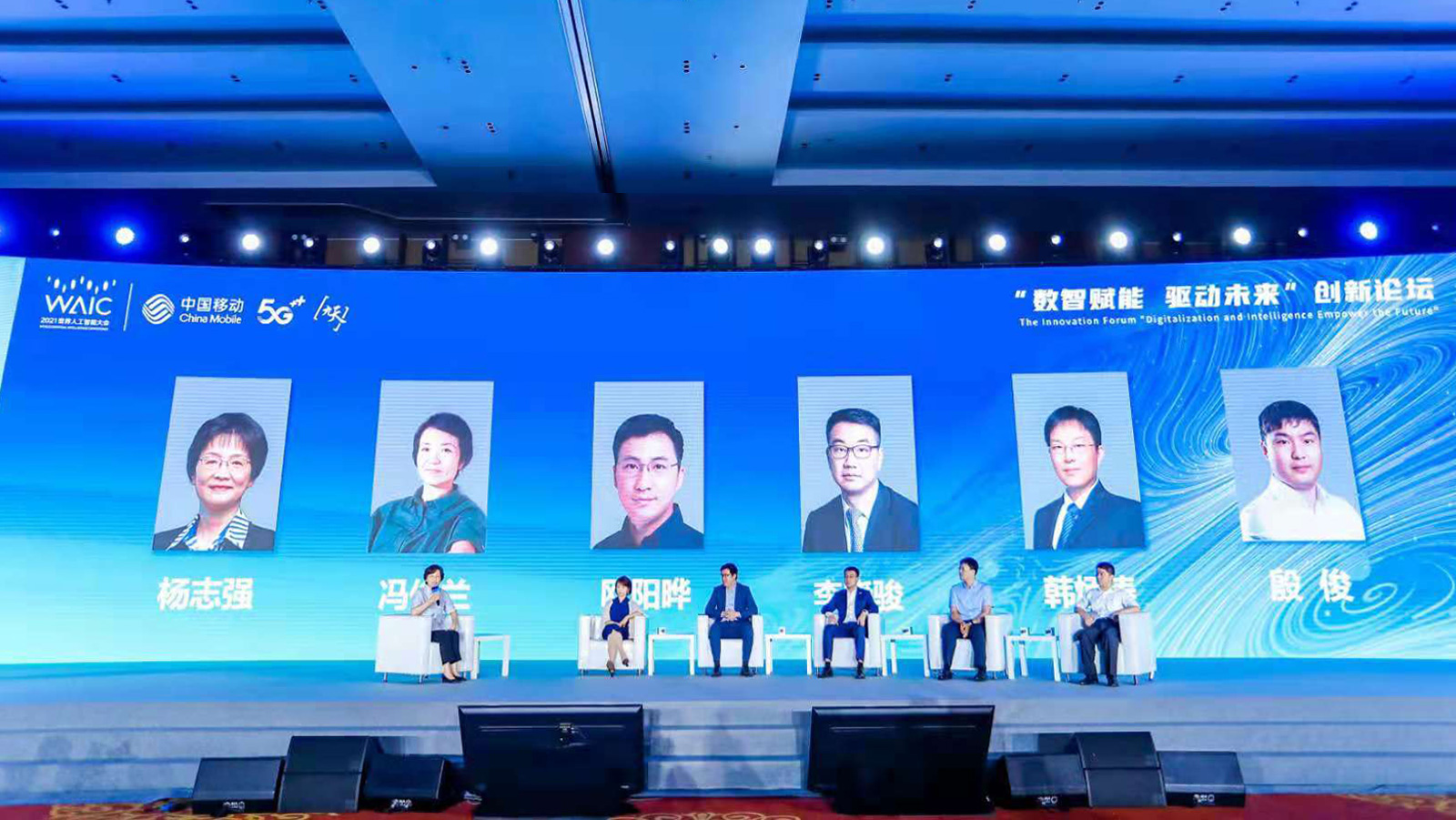Recently, the 2021 WAIC (World Artificial Intelligence Conference) co-sponsored by NDRC, Ministry of Industry and Information Technology, Ministry of Science and Technology, Cyberspace Administration of China, and the Shanghai Municipal Government had its grand opening in Shanghai. Dr. Ouyang Ye, the CTO and Senior Vice President of AsiaInfo, was invited to attend the innovation forum themed “Empowerment of Digital Intelligence Drives the Future”, and delivered a speech on “Joint Innovation of 5G + Artificial Intelligence Initiates and the Process of Intelligent Communication Networks” and other topics.

Photo: The Scene of 2021 WAIC
Focusing on popular topics such as 5G, AI, and new infrastructure, the forum invites leaders of competent departments, academicians, and representatives of leading companies were invited to exchange and share methods and cases of 5G+AI integration and innovation, and discuss how to build smart 5G networks and intelligent information infrastructure.

Photo: The scene of forum themed “Empowerment of Digital Intelligence Drives the Future”

Photo: Dr. Ouyang Ye delivered a speech at the forum themed “Empowerment of Digital Intelligence Drives the Future”
Talking about the development of network intelligence and the development process at home and abroad, Dr. Ouyang Ye put forward three suggestions: Firstly, clarify the concept and definition of network intelligence; secondly, determine the path and methodology of network intelligence; thirdly, adhere to one core methodological idea to promote network intelligence.
Clarify the concept and definition of network intelligence
Network intelligence is a broad concept, which can be divided into “intelligence-based network infrastructure” and “intelligence-based network management and operation” from perspective of the communication network ecosystem.
Dr. Ouyang Ye said that there is little difference between Chinese and foreign operators in terms of “intelligence-based network infrastructure”, but there are two differences in the 5G network infrastructure following the route defined by 3GPP: The first one lies in the network AI network element NWDAF. Foreign operators may tend to build independent NWDAF network element, while Chinese operators tend to arrange the quality management center or performance management center of the OSS system to assume the corresponding functions. Currently, AsiaInfo and CMRI are also conducting experiments and tests for AI network elements and application cases. The second one lies in the intelligence-based wireless networks. Due to openness and other issues, some European and American operators will increasingly tend to take the route of ORAN in the future, and RIC, the very important wireless AI network element, is the first intelligent network element on the wireless side. Chinese operators continue to take the route of 3GPP for 5G wireless network. The real-time intelligent optimization of the wireless side is mainly based on the built-in optimization strategy of wireless manufacturers, supplemented by the implementation of the SON function in the network optimization system of operators.
“Intelligence-based network management and operation” simply means that the OSS system and network management and operation methods of operators evolve towards automation and intelligence. Chinese operators tend to build a middle-ground system, which is a change in management methods, that is, exporting the capabilities of data middle-ground and AI middle-ground to each center of the OSS system. For example, China Mobile’s latest OSS system is committed to building a general technology platform, aiming to clarifying 45 intelligent scenarios to improve its intelligence capabilities based on this platform. These are all very useful attempts for intelligence development. Since foreign operators are more sensitive to the cost of operations labor, they pay more attention to the automation and intelligence of labor intensive network operations, such as wireless-side SON and the improvement of 360° experience management in the customer journey.
Determine the path and methodology of network intelligence
International standards organizations such as TMF, GSMA, and ETSI have defined and set their own classifications for network intelligence, and keywords about network intelligence are also emerging one after another, such as autonomous driving networks, autonomous networks, on-demand networks, intention-based networks, etc. But what is the path and methodology to truly achieve the network classification goal of autonomous driving? Will the network intelligence of communication operators reach a certain level and grade if enough hardware and software products for network intelligence are put together? Obviously not.
AsiaInfo, in conjunction with China Telecom, China Mobile, Verizon, AT&T, and Tsinghua University, has provided the realization path and methodology of network intelligence in the article “The Next Decade of Communication Artificial Intelligence”. The article defines and introduces communication artificial intelligence and its methods, principles, paths and frameworks to gradually realize the intelligence classification goals of operators’ networks, and provides the path and method to realize intelligence for the core network, wireless access network, transmission network, OSS system of network management, and supporting BSS system of IT business in the communication ecosystem.
The core of advancing network intelligence is “communication + AI” instead of “AI + communication”
In order to achieve and continuously improve the level of network intelligence, it is necessary to insist one core method, that is, communication knowledge + AI professional knowledge, rather than reverse AI + communication.
Classic wireless simulation models such as COST and Walfish have been written into 3GPP’s proposal in the eras of 2/3/4G. After 5G Massive MIMO, the industry continues to use the RayTracing simulation models of Bell Labs and New York University by default. However, in recent years, there have been some network intelligence methods for the sake of using AI, that is, completely abandoning the principle of communication simulation, and conducting calculations from input to output by purely using AI algorithms, which results in a lack of physical interpretability for communication in the mathematical reasoning process and results. The correct method for the intelligent optimization of wireless network should be based on a communication model with physical significance, and then AI algorithms should be added to converge and optimize the model, rather than doing exactly the opposite.
AsiaInfo is working with customers and partners in the communications industry to achieve 5G network intelligence based on communications artificial intelligence. At the same time, it provides 5G intelligent private network services for government and industry customers to promote the digital transformation of various industries.





